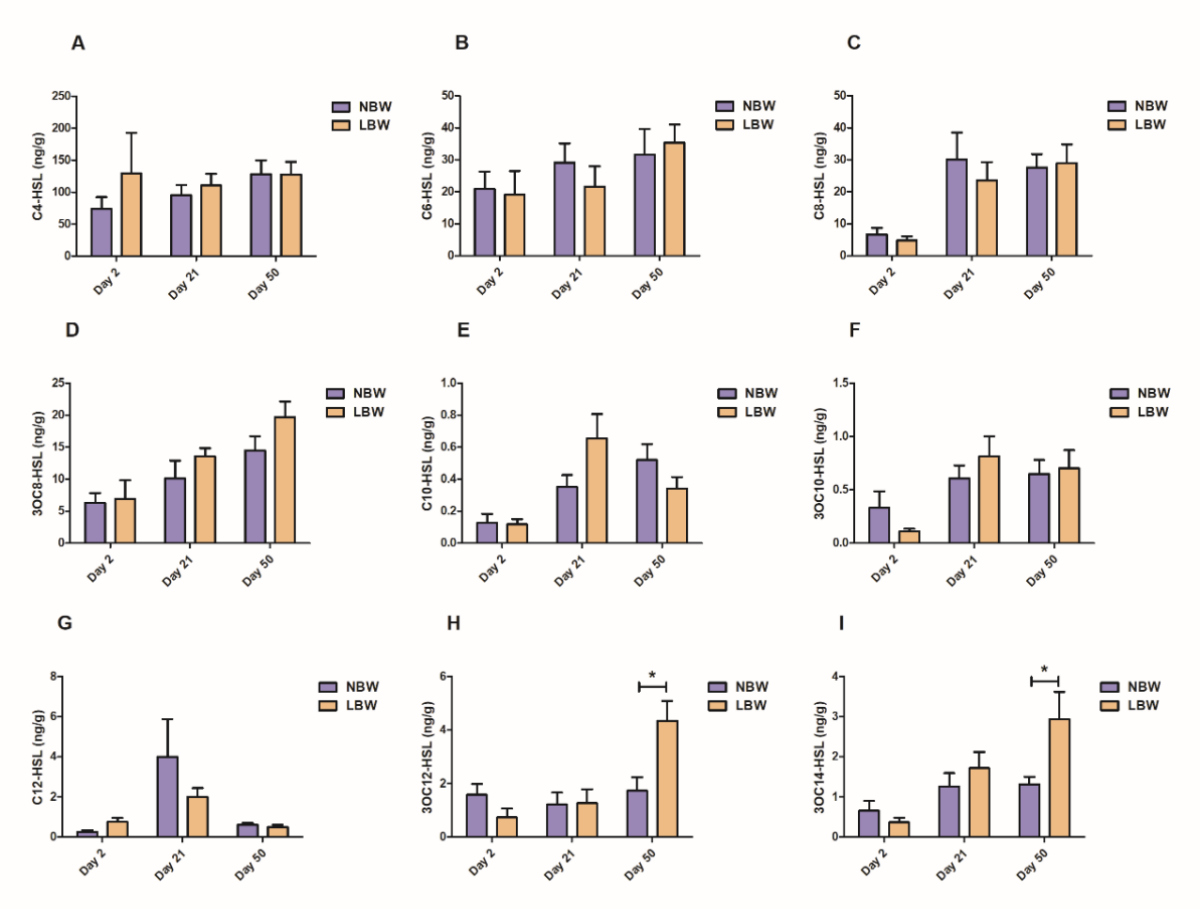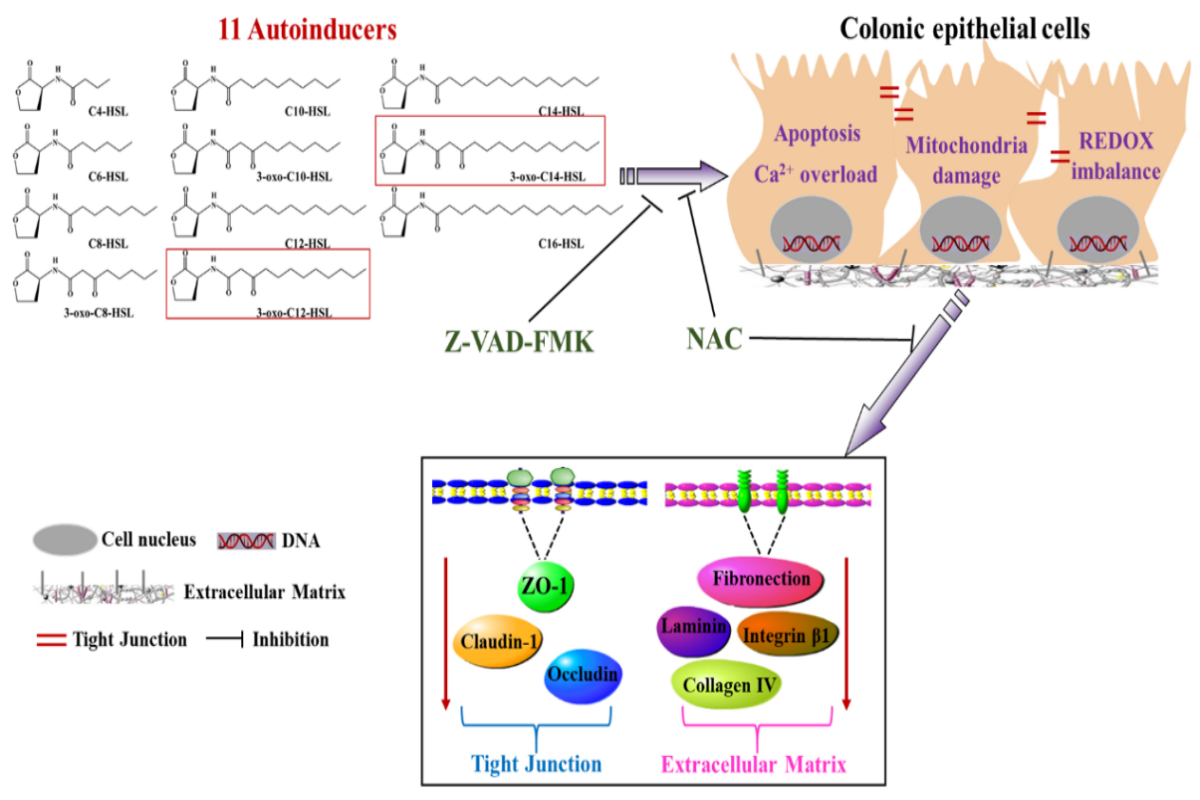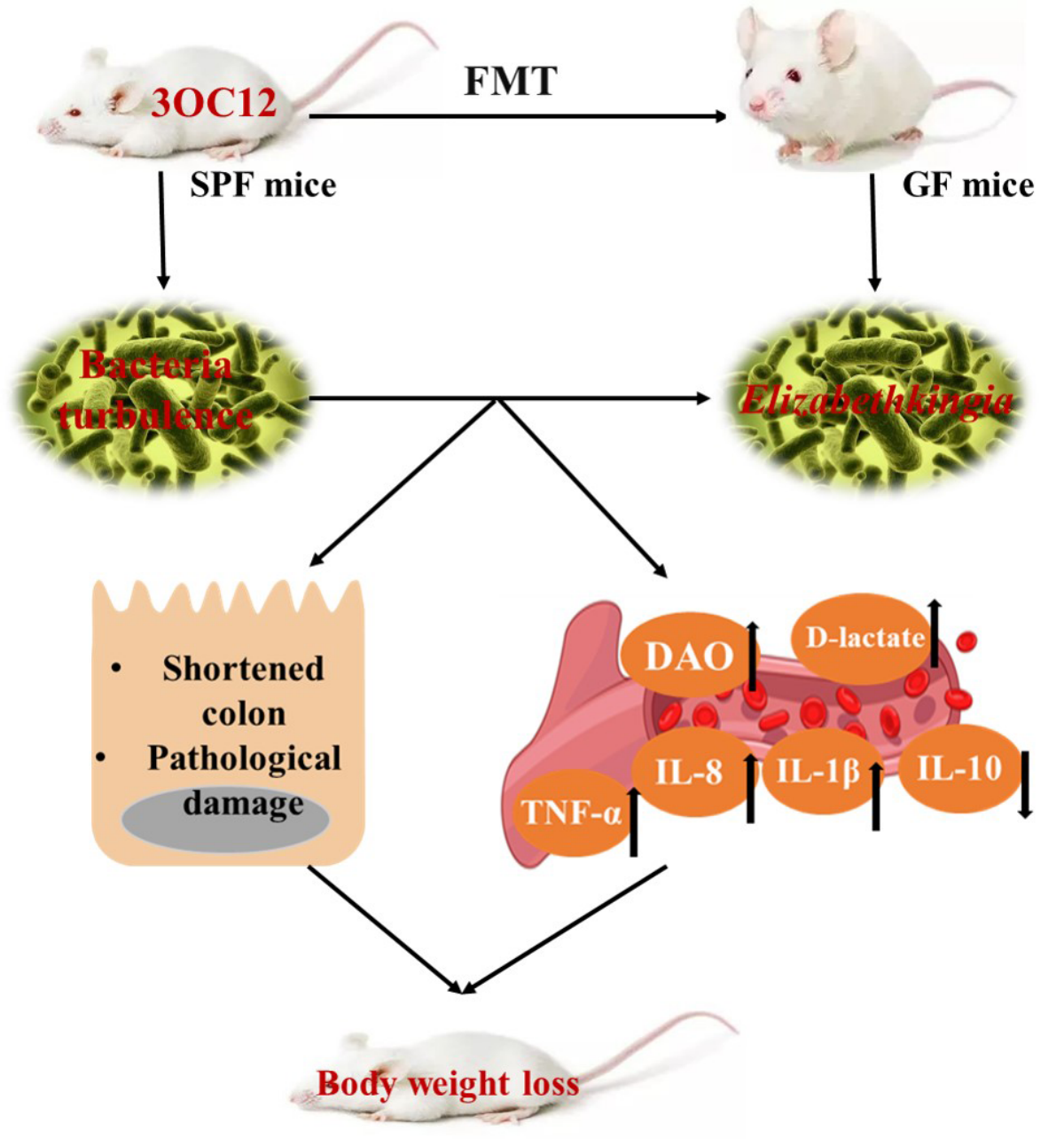南湖新聞網訊(通訊員 陶詩煜)近日,我校魏泓教授團隊針對腸道微生物群體(ti) 感應(QS)信號分子調控宮內(nei) 生長受限(IUGR)仔豬腸道損傷(shang) 這一領域開展係統深入的研究,在國際學術期刊Science of the Total Environment,Gut Microbes,Microbiology Spectrum,Frontiers in Immunology,Journal of Cellular Physiology和The Journal of Nutrition上發表了係列研究論文。揭示了IUGR仔豬腸腔中微生物QS信號分子的變化及其調控腸道屏障功能損傷(shang) 的分子機製,為(wei) 預防IUGR所致腸道疾病的發生提供了新思路,為(wei) IUGR仔豬營養(yang) 生理調控關(guan) 鍵靶點的篩選提供了理論依據。
IUGR導致的仔豬低初生重及繼發的哺乳期高死亡率和全期低生長性能,是養(yang) 豬業(ye) 存在的主要問題之一。據統計,受IUGR影響,我國15%~20%的仔豬初生重低於(yu) 1.1 kg。IUGR仔豬通常伴有出生後腸道功能障礙,從(cong) 而影響動物出生後的生產(chan) 潛力。相比於(yu) 正常仔豬,IUGR仔豬的後期飼料利用效率降低30%,平均出欄時間延長30天,每年給我國養(yang) 豬生產(chan) 帶來的經濟損失達150億(yi) 元。因此,改善IUGR仔豬的腸道健康狀況對於(yu) 確保生豬健康養(yang) 殖十分重要而迫切。研究團隊前期發現IUGR所致的腸道發育缺陷可以從(cong) 新生持續到生長階段,由氧化應激和細胞凋亡所致的腸道屏障功能損傷(shang) 是IUGR豬腸道發育缺陷的生物學基礎。
QS是原核生物中一種基於(yu) 分子信號的通訊機製。QS信號分子不僅(jin) 能夠控製微生物群落行為(wei) ,還可調節宿主細胞的生理狀態。研究表明,革蘭(lan) 氏陰性菌通過分泌QS信號分子調節真核細胞的功能,破壞宿主腸道上皮細胞的穩態,最終導致腸上皮屏障功能障礙。研究團隊前期發現,以擬杆菌屬和梭杆菌屬為(wei) 代表的革蘭(lan) 氏陰性菌是IUGR仔豬腸道中的優(you) 勢菌群。然而,目前尚不清楚IUGR仔豬腸腔內(nei) 革蘭(lan) 氏陰性菌的大量繁殖是否增加QS信號分子的分泌?基於(yu) 此科學問題,通過檢測正常和IUGR仔豬糞便中9種典型的革蘭(lan) 氏陰性菌源的QS信號分子濃度發現3OC12-HSL在IUGR仔豬中顯著升高;以瘤胃球菌為(wei) 代表的革蘭(lan) 氏陽性菌在IUGR仔豬腸道中顯著降低,且幾乎所有的差異瘤胃球菌均與(yu) 3OC12-HSL濃度呈顯著負相關(guan) ,該結果為(wei) IUGR仔豬腸腔內(nei) 存在革蘭(lan) 氏陰性菌來源的QS信號分子提供了直接證據。

圖1 正常和IUGR仔豬糞便中9種典型的革蘭(lan) 氏陰性菌源QS信號分子濃度
研究剖析了微生物QS信號分子3OC12-HSL介導IUGR仔豬腸道屏障功能損傷(shang) 的分子機製。體(ti) 外細胞試驗結果表明:3OC12-HSL可通過誘導腸上皮細胞氧化應激與(yu) 凋亡、破壞細胞外基質與(yu) 緊密連接蛋白,從(cong) 而影響腸上皮細胞增殖、破壞屏障功能;而抗氧化劑NAC和細胞凋亡抑製劑Z-VAD-FMK可阻止3OC12-HSL對腸上皮屏障的破壞作用,進一步明確了氧化應激與(yu) 凋亡通路在該過程中的介導作用。基於(yu) 無菌小鼠體(ti) 係進一步揭示了3OC12-HSL導致腸道屏障功能損傷(shang) 的微生物介導機製:3OC12-HSL破壞SPF小鼠腸道上皮屏障,誘導全身炎症反應;將SPF小鼠的糞便微生物移植給無菌小鼠後,無菌小鼠幾乎複製了3OC12-HSL處理的SPF小鼠的所有表型;通過微生物組學聯合分析發現Elizabethkingia spp.是SPF和無菌小鼠腸道中共同的差異細菌,該研究利用無菌動物模型和糞便微生物移植技術,首次在動物體(ti) 內(nei) 證明了QS信號分子3OC12-HSL通過調控特定微生物破壞腸道屏障功能,該研究方法為(wei) 解析豬功能微生物與(yu) 宿主互作機製提供了新思路。基於(yu) 上述研究成果形成了綜述性論文,該論文對革蘭(lan) 氏陰性菌QS信號分子在調節宿主細胞功能和腸道健康中的重要性進行了全麵的綜述,並提出通過阻斷QS信號分子發揮其功能的途徑來應用於(yu) 防治人類和動物腸道疾病的可能性。

圖2 QS信號分子3OC12-HSL介導腸道屏障功能損傷(shang) 的分子機製

圖3 QS信號分子3OC12-HSL導致腸道屏障功能損傷(shang) 的微生物介導機製

圖4 革蘭(lan) 氏陰性菌QS信號分子對宿主腸道健康的影響
該研究團隊長期致力於(yu) 腸道功能微生物的發掘及利用無菌動物體(ti) 係對功能微生物進行功能驗證。通過整合腸道功能微生物組與(yu) 無菌動物實驗技術,發現了糞菌移植通過調控宿主免疫和腸道屏障功能緩解無菌小鼠結腸炎的敏感性;闡明了益生菌(丁酸梭菌)及其衍生的胞外囊泡通過調節腸道內(nei) 穩態及腸道菌群以改善急性實驗性結腸炎,該研究為(wei) 以腸道功能微生物為(wei) 靶點防治炎症性腸道疾病提供了新的見解,並促進了炎症性腸道疾病的新型治療和預防幹預措施的發展。
我校魏泓教授團隊陶詩煜副研究員為(wei) 係列論文的第一或通訊(含共同)作者,研究得到中國農(nong) 業(ye) 大學王軍(jun) 軍(jun) 教授和浙江省農(nong) 業(ye) 科學院楊華研究員的支持,上述研究受到國家自然科學基金、國家重點研發計劃和校自主科技創新基金的資助。
審核人:魏泓
【英文摘要1】
Quorum sensing is a molecular signaling-based communication mechanism in prokaryotes. In the basic mode, signaling molecules released by certain bacteria are sensed by intracellular receptors or membrane-bound receptors of other members in the community, leading to the collective isogenic signaling molecule synthesis and synchronized activities. This regulation is important for the symbiosesis of the bacterium with the host, as well as virulence and biofilm formation. Notably, quorum sensing signaling molecules are not only able to control microbial community behavior but can likewise regulate the physiological status of host cells. Here, we provide a comprehensive review of the importance of quorum sensing signaling molecules in gram-negative bacteria in regulating host cell function and gut health, and suggest possible opportunities for application in combating human and animal diseases by blocking the pathways through which quorum sensing signaling molecules exert their functions.
【英文摘要2】
As a quorum sensing signal molecule, N-(3-oxododecanoyl)-homoserine lactone (3OC12) regulate the population behavior of microorganisms. Many studies have proved that 3OC12 harm the physiological function of host intestinal epithelial cells. However, the detrimental effects of 3OC12 on intestinal health need verification in animals. Besides, the role of gut microbiome in 3OC12-induced intestinal damage also needs further understanding. In our study, 3OC12 was first administered to specific pathogen-free (SPF) mice, then the fecal microbiome of SPF mice was transplanted into germ-free (GF) mice to reveal the effects of 3OC12 on intestinal health and regulatory mechanisms of the intestinal microbiome. 3OC12 treatment significantly decreased body weight, shortened colonic length, disrupted the morphology of the colonic epithelium and increased the histopathological score of the colon in SPF mice. The levels of diamine peroxidase, d-lactate, TNF-α, IL-1β, and IL-8 were found to be significantly elevated in the serum of 3OC12 mice, while the levels of IL-10 were significantly reduced. Besides, the fecal microbial community of mice was also altered in the 3OC12-treated SPF mice. The results of fecal microbial transplantation (FMT) experiment showed that the phenotypes in SPF mice were almost reproduced in GF mice, manifested by body weight loss, colon damage and changed in serum chemical markers. More importantly, a joint analysis of fecal microbes in SPF and GF mice revealed Feature14_Elizabethkingia spp. was common differential bacteria in the feces of two kinds of mice treated with and without FMT. Our results demonstrated that 3OC12 challenge led to systemic inflammation and body weight loss in mice by disrupting intestinal barrier function, in which gut microbiome played a key role. These findings increased our understanding of the mechanism of intestinal injury caused by 3CO12, providing new ideas for the prevention and therapy of diseases caused by bacterial infection from the perspective of intestinal microbiome.
【英文摘要3】
Microbes employ autoinducers of quorum sensing (QS) for population communication. Although the autoinducer of Pseudomonas aeruginosa LasI-LasR system, N-(3-oxododecanoyl)- l -homoserine lactone (3OC12), has been reported with deleterious effects on host cells, its biological effects on integrity of the intestinal epithelium and epithelial barrier are still unclear and need further investigation. In the present study, flow cytometry, transcriptome analysis and western blot technology have been adopted to investigate the potential molecular mechanisms of 3OC12 and its structurally similar analogs damage to intestinal epithelial cells. Our results indicated that 3OC12 and 3OC14 trigger apoptosis rather than necrosis and ferroptosis in intestinal epithelial cells. RNA-sequencing combined with bioinformatics analysis showed that 3OC12 and 3OC14 reduced the expression of genes from extracellular matrix (ECM)-receptor interaction pathway. Consistently, protein expressions from ECM and tight junction-associated pathway were significantly reduced after 3OC12 and 3OC14 challenge. In addition, 3OC12 and 3OC14 led to blocked cell cycle, decreased mitochondrial membrane potential, increased reactive oxygen species level and elevated Ca2+ concentration. Reversely, the antioxidant NAC could effectively mitigate the reduced expression of ECM and tight junction proteins caused by 3OC12 and 3OC14 challenge. Collectively, this study demonstrated that QS autoinducer exposure to intestinal epithelial cells ablates the ECM and tight junctions by triggering oxidative stress and apoptosis, and finally disrupts the intestinal epithelial barrier. These findings provide a rationale for defensing QS-dependent bacterial infections and potential role of NAC for alleviating the syndrome.
【英文摘要4】
Microbiological treatments are expected to have a role in the future management of inflammatory bowel disease (IBD).Clostridium butyricum(C. butyricum) is a probiotic microorganism that exhibits beneficial effects on various disease conditions. Although many studies have revealed thatC. butyricumprovides protective effects in mice with colitis, the wayC. butyricumestablishes beneficial results in the host remains unclear. In this study, we investigated the mechanisms by whichC. butyricummodifies the gut microbiota, produces bacterial metabolites that may be involved, and, specifically, how microbial extracellular vesicles (EVs) positively influence IBD, using a dextran sulfate sodium (DSS)-induced colitis murine model in mice. First, we showed thatC. butyricumprovides a protective effect against colitis, as evidenced by the prevention of body weight loss, a reduction in the disease activity index (DAI) score, a shortened colon length, decreased histology score, and an improved gut barrier function, accompanied by reduced levels of pathogenic bacteria, includingEscherichia/Shigella, and an increased relative abundance of butyrate-producingClostridium sensu stricto-1andButyricicoccus. Second, we also confirmed that the gut microbiota and metabolites produced byC. butyricumplayed key roles in the attenuation of DSS-induced experimental colitis, as supported by the profound alleviation of colitis effects following fecal transplantation or fecal filtrate insertion supplied fromC. butyricum-treated mice. Finally,C. butyricum-derived EVs protected the gut barrier function, improved gut microbiota homeostasis in ulcerative colitis, and contributed to overall colitis alleviation.
:



